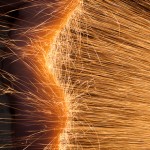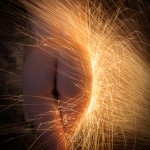Whenever I post one of my Sparks photos I get bombarded with requests on how I achieved the effect. It is a relatively easy effect to but does take some planning and caution. In this post I’ll go through all the steps I use in creating these sparks photos.
Disclaimer: This technique is very dangerous and I DO NOT recommend you attempting this yourself.
Concept
The idea behind the sparks photos are to bounce a shower of sparks off of the models body. This is accomplished by doing a long exposure shot and generating the sparks using an angle grinder.
What you will need
- Tripod
- Intervalometer or an assistant.
- Angle Grinder
- Cold Roll Steel bar stock(IMPORTANT – It must be cold roll steel, most other metals generate hot sparks that will burn your model).
- Safety Glasses
- Fire Extinguisher
– 10lb AB or ABC
Safety
There are lots of ways to hurt yourself and your model when doing sparks photos and again I recommend you DO NOT attempt this. The dangers are fire, flying projectiles, burns, and getting particles in your eyes. If you are dead set in trying this technique be sure to follow some common-sense safety practices.
Fire
Area – Do not attempt this in an area where there is combustible material. All my shots are done in a concrete room with concrete walls and floors. This could also be done outdoors at the beach, but I would not attempt it around trees, or dried grass. Also have a fire extinguisher with you and within reach! Don’t use one of those small wimpy fire extinguishers, get a decent sized one, I recommend a minimum of a 10lb AB or ABC extinguisher.
Clothing – I only use nude models for these shots so there is no danger of any clothing catching on fire, do not use this technique on clothed models.
Hair – Hair also burns so be sure the models hair is up in a bun and away from the sparks. There should be no gels or other hair styling product in the model’s hair as many of these products are flammable.
Flying Projectiles
The angle grinder is spinning very fast and can propel chunks of metal at high velocities towards your model. It is fast enough to penetrate the skin which is not a good thing. You want to make sure that no pieces of your cold-roll steel are going to break loose and be thrown at your model. You also need to have a large enough piece of cold-roll steel that you can safely grip it. I recommend flat bar stock at least 1.5” wide and 14” long. As you grind the metal it is going to get thin in places and can possibly break loose, so before each series of shots break these pieces off by hand (or grind them off)
Eye Protection
The sparks the grinder is throwing off are red hot particles of metal which can do serious damage if they were to get in your eyes. Everyone in the room should wear eye protection! If the model’s face is visible in the shot then they should close their eyes whenever the grinder is running. If you want a shot where the models eyes appear open, take a shot without the sparks with their eyes open and then have them close their eyes and shower them with sparks. You can then merge the two images in Photoshop to make it appear that their eyes were open in the shot. Never throw sparks at the model while their eyes are open!
Burns
The sparks are particles of burning metal and can burn the skin. There are several ways to minimize this, one is to make sure you use cold-roll steel. The sparks that are thrown off are much cooler than other metals such as hot-roll or stainless steel. The sparks cool off as they travel away from the grinder, so they will be hottest close to the grinder and cooler the further away you get from the grinder, so stand back away from the model. I am typically 5-6 feet away from the model when showering them with sparks.
Alright, now that we got all that out of the way let’s move on to the setup.
Setup
Setting up your camera.
Use a tripod – Because these shots use long exposure your camera needs to be on a tripod. The type of tripod is not important as long it holds your camera steady.
Turn off Image Stabilization – If the lenses or camera you are using has image stabilization, turn if off.
Turn off Auto Focus – Because you are shooting long exposure you will want the room to be fairly dark. As a result of this the camera will probably have trouble auto-focusing, so I recommend setting your camera to manual focus. Compose your shot, focus on the model and you should be all set.
Interval Timer (Intervalometer) – If you are shooting with an assistant then an interval timer is optional. But if you are shooting alone is essential, since you cannot be using the angle grinder and pushing the shutter button at the same time. Here are the settings I use on my interval timer:
Initial delay: 10 seconds
Interval between shots: 1 seconds
Exposure length: 3 seconds
Number of Exposures: 6
The initial delay gives me enough time to start the Intervalometer and get in to position with the angle grinder before the first shot. I then start the grinder and will shower the model with sparks for 24 seconds (3 seconds exposure + 1 second interval) * 6 exposures. Some models can’t tolerate the sparks for that long, so I will stop when they tell me and let the camera take shots until the interval is complete and then delete the shots with no sparks.
Lighting
I use 3 types of lighting for my sparks photos and each give a slightly different look. I recommend you try all three methods to determine which look you like best.
No lighting – I make the room completely dark and just rely on the sparks to generate the light in my photograph. This often requires longer exposure times, or higher ISO which may not be desirable. The longer exposure times will often cause the model to be blurry because of slight movements. High ISO can result in noise in the image which may or may not add to the image. Give it a try.
Modeling Light – I setup one of my strobes with a large softbox and turn on the modeling light and use the light from that modeling light as my only source of illumination. Because of the long exposures the modeling light will result in a pretty good fill light and will give a little more definition to the model’s body.
Strobe – Using a strobe will freeze the model in the image and can minimize any blur caused by movement of the model during the long exposure. I will match the power of the strobe to the aperture setting I am using on the camera, typically either f/5.6 or f/8.
Camera Settings
I always start off with the following camera settings
Shutter Speed: 2 sec
Aperture: f/8
ISO: 100 if using modeling light or stobe, 800 if using no lighting.
I will then take a few shots and adjust my settings as necessary. If there are too many sparks or the majority of the sparks are over-exposed I will lower the shutter speed to 1 sec. The faster the shutter speed the fewer the sparks, and visa-versa.
Taking the Shot
Posing Considerations
There are several things to consider with posing.
Because these photos are done with a long exposure you need to make sure the model can hold the pose for the duration of the shot. They need to be balanced and it helps if they arms are somehow supported. For the image where the sparks are bouncing off the models hands, she rested her forearms on the back of a chair so they would not move during the shot. For the photo below of the model appearing to drink the sparks, her elbows are resting on the back of a chair so that her hands don’t move during the long exposure.
The most interested poses are ones where there is a contour to the body that the sparks much follow. Something that is going to block some portion of the sparks, or a nice curve to the body that the sparks can outline.
Grinder technique
Using the grinder to throw the sparks takes practice. You want to have a continous stream of sparks coming off of the grinder. This is not always easy because you are also sweeping the grinder back and forth to spray the sparks along the model’s body. This sweeping movement tends to make the metal not maintain good contact with the grinder.
If your grinder has a shield on it, I often will use the shield as a pivot point for the metal bar. I will rest a portion of the bar on the shield and then lever one end into the grinder. This helps me maintain the stream of sparks.
Once you have a stream of sparks going you want to sweep your arm up and down (or left to right), to direct the sparks against the model. Again this takes practice and it is recommended you practice first without the model.
Multiple Exposures
I will often take multiple exposures and combine them in Photoshop after the shoot. I do this for shots where I want it to appear the model’s eyes were open. I first take a shot with no sparks and the model’s eyes open, and then will have them close their eyes and take another shot with the sparks. I then combine these two photos using Photoshop.
I also use multiple exposures when I want to have sparks coming from multiple directions (as in the photo at the top of this post). I will first take a shot with the grinder on one side of the model and then I will take another shot from the opposite side then combine the two shots in Photoshop.
Conclusion
As I said in the introduction, this is dangerous and I recommend that you DO NOT attempt it. But if you do, share your photos with me, I would love to see them.




Do you have any video from this photoshoot?
3 years late but a great tutorial. Thanks for taking the time to do this.